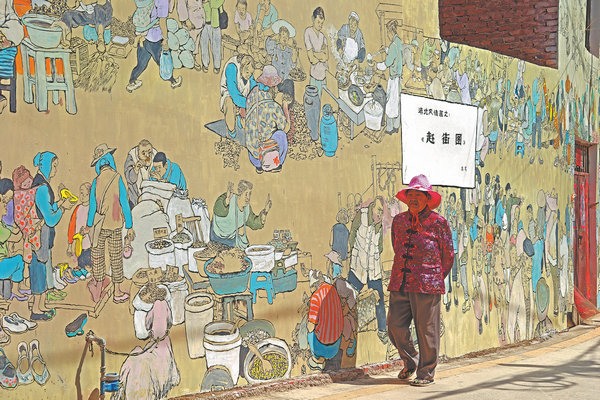
A villager walks past a mural by cartoonist Li Kunwu, 69, who has injected an artistic vibe into Duqu village, Kunming, Yunnan province. [Photo provided to China Daily]
A wall painting of happy villagers playing musical instruments, accompanied by an attentive dog, draws the eye the moment one sets foot in Duqu village. The mural graces the wall of a power distribution room near the entrance to the village on the banks of Dianchi Lake, about 50 kilometers to the southwest of downtown Kunming, capital of Yunnan province.
Walking a bit farther inside, two larger wall paintings reveal themselves. They face onto the village square, which doubles up as a parking lot and as a place to dance.
One features scenes of residents singing and dancing together, and the other a panoramic view of the village that highlights landmarks, such as its lotus flower pool and an old temple.
Others telling the story of Duqu's origins, the local way of life, as well as folk culture, are scattered around the village.
They are all the work of Li Kunwu, 69, a well-known cartoonist, who won the 2010 best history cartoon award at the Les Rendez-vous de l'Histoire in France, one of the largest historical book fairs in Europe.
"When I was young, I also lived in a village next to Dianchi Lake, and the first time I entered Duqu, I felt its rustic, quaint atmosphere, untouched by commercialization, which I really liked a lot," says Li, from Kunming, who was named a cultural ambassador for Dianchi by local authorities in March last year.
The role has since given him incentives to conduct research and field trips to villages along the banks of the lake.
Li's original plan was simply to hold an art exhibition in Duqu, but upon arriving in the village, he decided to paint directly on its walls, so his work would be better integrated with the village setting.
"I have published many books abroad and organized art exhibitions, in the hopes of making our culture and customs known to more people. But I have always had a wish, which is to bring my comics about nostalgia back to my hometown. So, these murals can be considered as fulfilling that wish," Li says.
The endeavor was something of a challenge, as Li had never painted on walls before. The biggest difficulty was the difference in perspective.
"When I draw on paper, I can see the overall effect at a glance, but with murals, you need some distance to see clearly. It was difficult to grasp this at the beginning, such as how large a figure should be drawn, which required me to adapt constantly," Li says.
Other challenges included needing to rely on his intuition without making drafts, and improvising as he went along.
His goal was to convey a sense of nostalgia, which he says is "a complex, yet rich sentiment that needs diverse content and formats to express".
In order to save time commuting back and forth, Li decided to stay in Duqu, immersing himself in the daily lives of the villagers.
"After I arrived, they were very happy and welcomed me with open arms," Li says. "They felt a sense of familiarity seeing their lives depicted on the walls."
At the beginning, he leaned more toward rural landscapes, without much of a narrative, but in the process of painting, he says he came to understand that there were many interesting aspects about the village.
"For example, some people told me about a legendary white cow in their village, which is very rare for locals. The villagers are proud of it, so I painted an image of it," he says.
He also drew inspiration from the villagers themselves.
"While I was painting, an elderly couple holding hands walked past me. I found this very moving, and conveniently, there was a wall nearby, so I painted this real-life scene on it," he says.